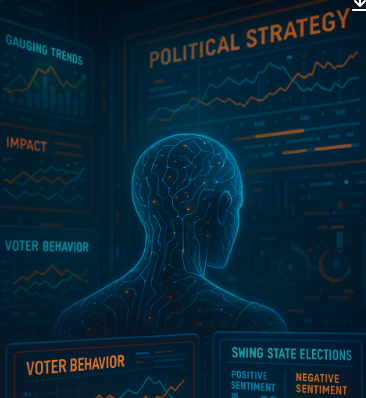Groundbreaking integration of artificial intelligence and sentiment analysis is revolutionizing voter opinion measurement.
What to Know:
- Most major pollsters, including Selzer, Marist, and Quinnipiac, missed 2024 outcomes by wide margins—some by over 10 points.
- Brad Parscale’s AI platform accurately predicted 49 out of 50 states and Trump's national popular vote win.
- Instead of relying on small survey samples, EyesOver tracks millions of real-time online conversations to gauge voter sentiment.
- This tech mirrors what brands like Nike and Netflix use to measure emotional reactions and adjust strategy on the fly.
- While powerful, AI-driven sentiment tracking raises major concerns about privacy, manipulation, and lack of political regulation.
The landscape of political forecasting is undergoing a seismic shift, propelled by the groundbreaking fusion of artificial intelligence and real-time sentiment analysis. As traditional polling methods stumbled in recent electoral contests, a new breed of firms is emerging to redefine how we gauge public opinion.
Image: Screenshot from EyesOver website
At the forefront of this revolution is EyesOver, spearheaded by the innovative mind of Brad Parscale and recently discussed in an article in Townhall by Chris Wilson, who was recently invited to become CEO. Parscale’s pioneering approach promises a more precise and dynamic understanding of voter sentiment, ushering in an era where campaigns can tap into the electorate's pulse with unusual accuracy.
Dramatic Shift in Polling Accuracy
The 2024 election cycle demonstrated significant limitations in legacy polling approaches. Wilson describes how Ann Selzer, considered among the most reliable pollsters, dramatically missed the Iowa outcome by 16 points. Similarly, The New York Times inaccurately forecasted results in Nevada and Arizona, each by around 8 points. The Marist Poll predicted a 4-point national popular vote victory for Kamala Harris, who ultimately lost to Donald Trump by nearly 2 points—a striking 6-point discrepancy. Quinnipiac, another polling heavyweight, missed critical swing states Wisconsin and Pennsylvania by approximately 7 points each.
Even Morning Consult, with its extensive polling (17 polls released after Harris entered the race), failed to detect Trump’s eventual popular vote victory, consistently presenting Harris with a comfortable lead.
Enter EyesOver: AI-Driven Polling
Against this backdrop of conventional polling struggles, Brad Parscale, known for his digital acumen during Trump's campaigns, and Chris Wilson, founder of WPA Intelligence, introduced EyesOver, which harnesses AI to monitor real-time online conversations. Their technology collects vast quantities of data from social platforms such as Twitter (X), Reddit, and Facebook, analyzing sentiment, emotional intensity, and trending discussions through advanced natural language processing.
AI-powered sentiment analysis categorizes public opinion into emotional tones and trending political topics. OpenAI’s DALL·E (GPT-4o), 2025
Parscale’s AI platform demonstrated exceptional accuracy, correctly predicting the winner in every swing state and successfully forecasting Trump's national popular vote victory. The platform identified the winner in 49 out of 50 states, narrowly missing only New Hampshire. This is a shocking performance, far surpassing legacy polling averages, which missed outcomes by about 2.94 points in the final weeks.
A New Kind of Electoral Insight
Wilson says EyesOver’s methodology allows campaigns agility in responding to voter sentiment shifts long before traditional polls detect them. For example, the 2024 Trump campaign utilized such AI-driven insights from companies like CloudResearch to detect early economic anxieties among Latino voters in Nevada and Arizona. This facilitated targeted messaging adjustments that improved Trump's performance among Hispanic working-class voters.
EyesOver’s methods reflect successful sentiment-tracking strategies used widely by major consumer brands like Nike and Netflix, showcasing the broader applicability and accuracy of AI-driven insights. In marketing, sentiment tracking allows companies to assess campaign performance based on emotional tone, not just clicks or impressions. This helps teams course-correct mid-campaign and craft content that truly resonates with their audience.
Public relations teams also use AI to track brand reputation across digital platforms, flagging PR risks before they explode. Real-time feedback enables faster response strategies and improved public perception. Some tools now go even deeper—tracking how brand sentiment evolves across different channels and audience segments, making it a powerful tool not just for messaging but for identity management.
Change in Campaign Strategy: Ethical Considerations
Online conversation analysis could inadvertently amplify polarized or extreme voices while overlooking more moderate voters who are less active online. Large-scale social media scraping also raises concerns about privacy and the moral limits of data use.
Wilson acknowledges these concerns, emphasizing the importance of combining AI insights with traditional polling methods to offset inherent biases. Nonetheless, the potential for manipulation—through hyper-targeted advertising and emotionally charged messaging—is substantial. Political campaigns currently face limited regulation regarding AI-based data collection, unlike heavily regulated sectors such as finance or healthcare.
Wrap Up
The era of traditional polling is waning, giving way to AI-powered sentiment analysis. Parscale and Wilson's collaboration represents a pivotal moment—combining sophisticated AI analytics with seasoned political strategy to redefine electoral success. Campaigns must rapidly adapt, harnessing real-time sentiment tracking to navigate and capitalize on fast-moving voter dynamics.
The message to political strategists is clear: future elections will be decided not simply by who has the best message, but by who can most effectively gauge and respond to voter sentiment as it unfolds. The age of traditional polling is ending; the era of AI-driven voter engagement is just beginning.


